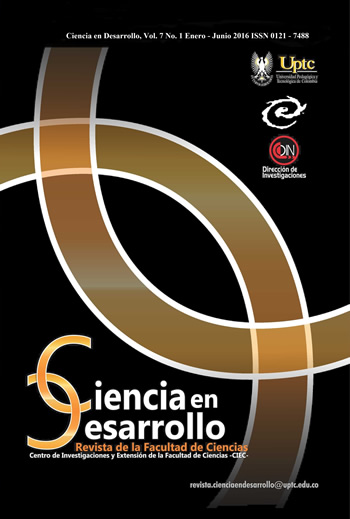Electrochemical Treatment of Water Polluted with β-Lactam Antibiotics.

Abstract
Oxacillin (OXA), cloxacillin (CLX) and Dicloxacillin (DCX) are β-lactam antibiotics, used to treat infections caused by gram-positive and gram-negative microorganisms, which can reach aquatic systems due to improper disposal or deficient water system treatments, thus representing a risk to the environment. With this work, the degradation of these -lactam antibiotics was investigated by anodic oxidation using a DSA anode Ti/IrO2. An experimental design with variables assessing current density, supporting electrolyte, and the concentration of substance, allowed to evaluate the most favorable conditions for the degradation of the β-lactams tested. The best eciencies in terms of pollutant and antibiotic activity removals, were obtained at high current level (121 mA) and average concentration of NaCl (0.225 mol L
Keywords
Isoxazolilpenicilinas, oxidación anódica, actividad antimicrobiana, ánodo tipo DSA. (Isoxazolyl Penicillins, Anodic Oxidation, Antimicrobial Activity, Anode Type-DSA.)
References
- M. R. Periago, “La resistencia a los antimicrobianos: un factor de riesgo para las enfermedades infecciosas”, Revista Panamericana de
- Salud Pública, vol. 30, pp. 507-509, 2011. DOI: https://doi.org/10.1590/S1020-49892011001200001
- A. Junza, N. Dorival-García, A. Zafra-Gómez, D. Barrón, O. Ballesteros, J. Barbosa et al., “Multiclass method for the determination of quinolones and -lactams, in raw cow milk using dispersive liquid–liquid microextraction and ultra high performance liquid chromatography–tandem mass spectrometry”, Journal of Chromatography A, vol. 1356, pp. 10-22, 2014. DOI: https://doi.org/10.1016/j.chroma.2014.06.034
- F. García, “Resistencia bacteriana a antibióticos”, Acta Médica Costarricense, vol. 43, pp. 101-102, 2001. DOI: https://doi.org/10.51481/amc.v43i3.62
- M. A. Guzmán M., J. Salinas L., P. Toche P., and A. Afani S, “Alergia a b-lactámicos”, Revista chilena de infectología, vol. 21, pp. 285-298, DOI: https://doi.org/10.4067/S0716-10182004000400002
- P. S. M. Dunlop, M. Ciavola, L. Rizzo, D. A. McDowell, and J. A. Byrne, “Eect of photocatalysis on the transfer of antibiotic resistance
- genes in urban wastewater”. Catalysis Today.
- OMS, Resistencia a los antimicrobianos, 2013.
- Y. Ishii, C. Ueda, Y. Kouyama, K. Tateda, and K. Yamaguchi, “Evaluation of antimicrobial susceptibility for -lactams against clinical isolates from 51 medical centers in Japan (2008)”, Diagnostic Microbiology and Infectious Disease, vol. 69, pp. 443-448, 2011. DOI: https://doi.org/10.1016/j.diagmicrobio.2010.10.033
- J. M. Cha, S. Yang, and K. H. Carlson, “Trace determination of -lactam antibiotics in surface water and urban wastewater using liquid
- chromatography combined with electrospray tandem mass spectrometry”, Journal of Chromatography A, vol. 1115, pp. 46-57, 2006. DOI: https://doi.org/10.1016/j.chroma.2006.02.086
- M. E. Epstein, M. Amodio-Groton, and N. S. Sadick, “Antimicrobial agents for the dermatologist. I. -Lactam antibiotics and related compounds”, Journal of the American Academy of Dermatology, vol. 37, pp. 149-165, 1997. DOI: https://doi.org/10.1016/S0190-9622(97)80118-1
- Today’s Drugs: Penicillins And Cephalosporins, Today’s Drugs: Penicillins And Cephalosporins, The British Medical Journal, vol. 2,
- no. 5604, pp. 542-545, 1968. Retrieved from http://www.jstor.org/stable/20392812
- M. A. Oturan and E. Brillas, “Electrochemical Advanced Oxidation Processes (EAOPs) for Environmental Applications”, Portugaliae Electrochimica Acta, vol. 25, pp. 1-18, 2007. DOI: https://doi.org/10.4152/pea.200701001
- M. Panizza, A. Barbucci, R. Ricotti, and G. Cerisola, “Electrochemical degradation of methylene blue”, Separation and Purification Technology, vol. 54, pp. 382-387, 2007. DOI: https://doi.org/10.1016/j.seppur.2006.10.010
- M. Panizza and C. A. Martinez-Huitle, “Role of electrode materials for the anodic oxidation of a real landfill leachate – Comparison between Ti–Ru–Sn ternary oxide, PbO2 and boron-doped diamond anode”, Chemosphere, vol. 90, pp. 1455-1460, 2013. DOI: https://doi.org/10.1016/j.chemosphere.2012.09.006
- R. E. Palma-Goyes, F. L. Guzmán-Duque, G. Peñuela, I. González, J. L. Nava, and R. A. Torres-Palma, “Electrochemical degradation of crystal violet with BDD electrodes: Effect of
- electrochemical parameters and identification of organic by-products”, Chemosphere, vol. 81, pp. 26-32, 2010. DOI: https://doi.org/10.1016/j.chemosphere.2010.07.020
- R. A. Torres, W. Torres, P. Peringer, and C. Pulgarin, “Electrochemical degradation of psubstituted phenols of industrial interest on Pt electrodes: Attempt of a structure–reactivity relationship assessment”, Chemosphere, vol. 50, pp. 97-104, 2003. DOI: https://doi.org/10.1016/S0045-6535(02)00487-3
- R. A. Torres, V. Sarria, W. Torres, P. Peringer, and C. Pulgarin, “Electrochemical treatment of industrial wastewater containing 5-
- amino-6-methyl-2-benzimidazolone: toward an electrochemical–biological coupling”, Water Research, vol. 37, pp. 3118-3124, 2003. DOI: https://doi.org/10.1016/S0043-1354(03)00179-9
- U. S. Pharmacopeial, “USP 35/NF 30 The United States Pharmacopeia”, p. 4141, 2012.
- D. C. Montgomery and G. C. Runger, “Applied Statics and Probability for Engineer. Design and Analysis of Experiments”, 3 ed., John Willey & Sons, INC., 2003.
- R.A. Torres, R. Mosteo, C. Pétrier, C. Pulgarín. “Experimental design approach to the optimization of ultrasonic degradation of alachlor and enhancement of treated water biodegradability”.
- Ultrasonics Sonochemistry, vol. 16, no. 3, 425-430, 2009. DOI: https://doi.org/10.1016/j.ultsonch.2008.08.004
- T. González, J. R. Domínguez, P. Palo, J. Sánchez-Martín, and E. M. Cuerda-Correa, “Development and optimization of the BDDelectrochemical oxidation of the antibiotic trimethoprim in aqueous solution”, Desalination, vol. 280, pp. 197-202, 2011. DOI: https://doi.org/10.1016/j.desal.2011.07.012
- P. D. Philip C. Singer and P. D. David A. Reckhow, “Chemical Oxidation”, in Water quality and treatment: a handbook of community water supplies, McGraw-Hill, Fifth Ed., p. 1248, 1999.
- M. Deborde and U. von Gunten, “Reactions of chlorine with inorganic and organic compounds during water treatment–Kinetics and
- mechanisms: A critical review”, Water Research, vol. 42, pp. 13-51, 2008. DOI: https://doi.org/10.1016/j.watres.2007.07.025
- C. Reyes, J. Fernández, J. Freer, M. A. Mondaca, C. Zaror, S. Malato, et al., “Degradation and inactivation of tetracycline by TiO2 photocatalysis”, Journal of Photochemistry and Photobiology A: Chemistry, vol. 184, pp. 141-146, 2006. DOI: https://doi.org/10.1016/j.jphotochem.2006.04.007